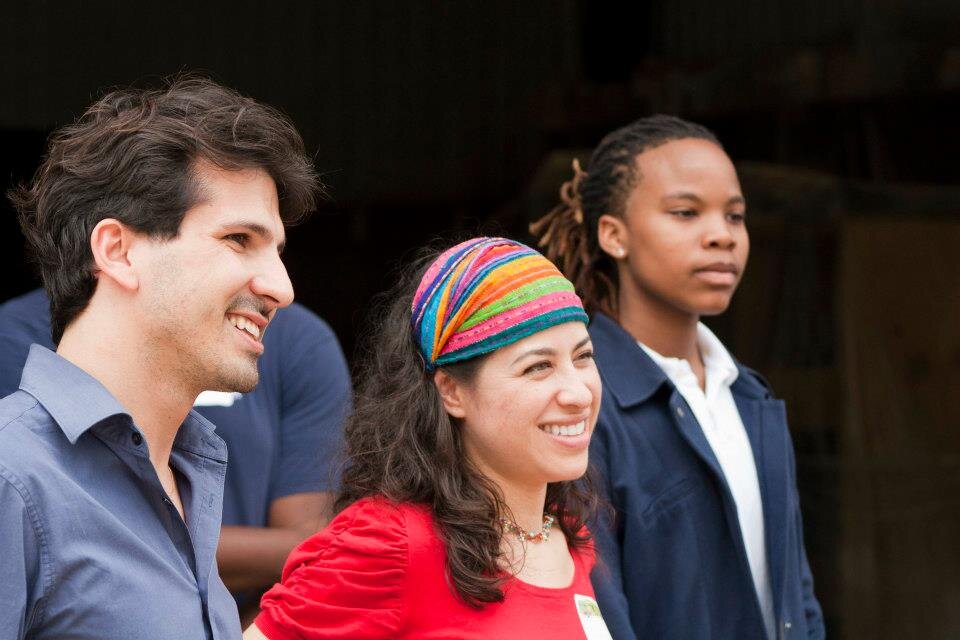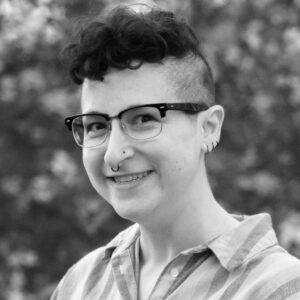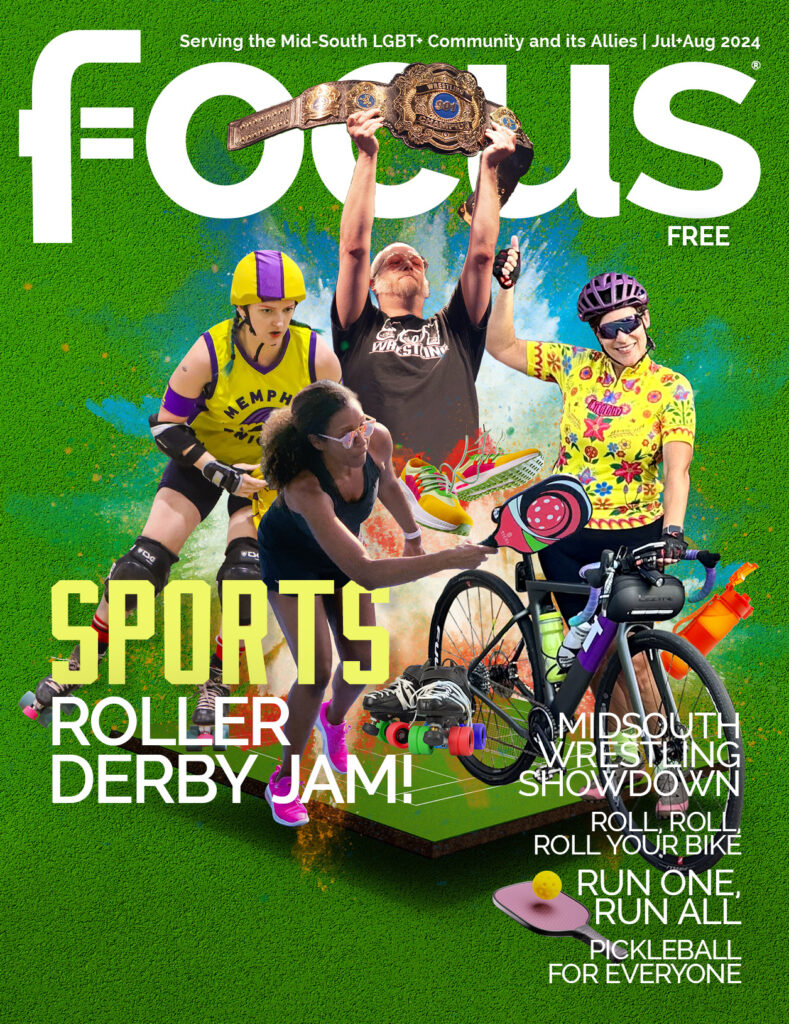by Sarah Rushakoff | photos courtesy of Yancy Calvo
Where were you born?
Mexico City
What was your favorite thing to do as a child?
My parents would take me and my siblings out of the city to “breathe” fresh air and to camp. My parents were very intentional in creating quality family time and helped us learn the importance of uniting with community. I learned so much about social justice and the things that can impact people who were different from me.
What was your first art experience?
My first art experience was through the National Museum of Anthropology in Mexico City. I was so blown away, and my first experiences with art were more archeological, ancient, historic, and hand- crafted cultural materials rather than more contemporary art. We also traveled around a lot, and we always saw so much community-driven art in the cities we visited. I loved seeing how people crafted things with their hands. These things influenced me, even though I had never engaged with an artist until I moved here for college. That was my professor (an awesome person named Pam Cobb who I trust to be supportive and honest in the most real ways). I loved large-scale pieces like the murals I saw in the cities we visited as a child.
What led you to art?
I was a Psychology major with a Marketing minor and later got my MBA. I try to put some of the general education courses at the end of college, so I could focus on my major. I had to take an art class or a music class or theatre as a requirement, so I just found a course that fit my schedule without much thought put into the actual course. That happened to be Acrylic Painting class, and I didn’t even know what that was! I had a major Aha! moment in that class, and I suddenly knew that was what I wanted to do. Unfortunately, it was too late in my college experience to start over, and I just wanted to finish my degree and move on to the next thing. I go back and think about my educational experience; when you’re young, you let others influence you and your decisions. I knew I loved art but didn’t know anyone who was an artist and I lacked an artist role model, and other people’s opinions mattered to me at the time. They said “you’re going to starve”, “there’s no future in this”, and I had to think about those things even though I was getting little messages from the universe that art was going to be part of my future. I didn’t act upon my art until years later. When I was working on my MBA, I had two desks: one desk was art and one desk was numbers and business. The hours would fly by deep into the night because I was working on art and would be having a blast mixing colors and creating. And I’d say “oh no, I need to turn in a paper for my MBA!”
I love how artists can move through the tough parts of creating and let an idea evolve and adapt and modify because you know that you hold the inspiration and intention authentically inside of you. There is so much beauty in creativity; and, we call ourselves artists, but there’s a little bit of artist in everyone. The difference is that we trust in the unknown and trust that it’s going to be fine and if it’s not the result you envisioned, it will still be authentic. This process reminds me of what John F. Kennedy said, “if art is to nourish the roots of our culture, society must set the artist free to follow his vision wherever it takes him.”
What artist/person inspires your art the most?
I couldn’t pinpoint an inspiration; but, I could say the more I get into social justice or applied art, the more I look up to organizations that aim to be socially engaged like Alternative Roots, National Association of Latino Arts and Cultures, and Mural Arts Philadelphia, among others. When you get into this work, one thing comes after another and you find where you fit. At the same time, you can feel insignificant in this huge fight for justice. There’s never a truly original idea, but when you have passion and authenticity, you can transform your idea in a way that is applicable and unique to your community. When framed in that way, it IS an original idea that can be applied with others in very innovative, unique, and sustainable ways.
What led you to Memphis?
I was on my way home to Mexico City after doing some social work in Mozambique. I stopped in Memphis to visit my brother, who was going to school at Christian Brothers University. I fell in love with the school, the campus, and the city!
What is your favorite aspect of Memphis?
I love the diversity and the ongoing potential of this city. I met my husband here, he’s also from Mexico City. My friend groups at CBU were so diverse, and there are so many diverse groups in Memphis as well. I don’t know if people know how diverse we are, but we are so rich in that aspect. The upside of Memphis being smaller than other cities, is that you are able to see the little differences your work is making, and to me, that is meaningful. If you are present and show up, you will be able to connect to other sectors and connect to different circles too.


I see the applied intersection of art and social justice in your CV. Can you tell me more about the importance of representation of Latina women in public art spaces?
It is essential to validate the existence of everyone regardless of race, background, religion, gender, and sexual orientation. Public art in neighborhoods should be created with and for them in mind; it should tell their individual and collective story providing a sense of belonging and identity. It is important for Latina women to be represented as well as every other minority; it’s about equality and access. Public artists, Latina or not, must strive to include the community in every phase of the art project; we must honor the stories and I strongly believe that we must serve as mentors to the youth of that community for at least the length of the period of the art project. Even if we don’t look like the majority of the community members, we (artists) should honor the space by acknowledging our differences, showing a willingness to learn about their history/story, involving them in the process, and creating artwork that exemplifies how art elevates everyone.
I wrote a short piece on Native Voices that came to the Brooks last year, where the focus was on de-colonizing museum spaces and placing indigenous faces and artists as producers of art at the forefront (rather their culture and art being stolen and plagiarized by non-native peoples).
Do you think that Latina voices and faces are lacking in public art and public museums?
Yes, most definitely, like many minorities, Latinx art and Latinx artists’ voices (especially women) are lacking in public art and public museums. Parallel to the white Euro mainstream is the Latino male-dominated society where women artists’ contributions have not equally been highlighted. I feel this is slowly improving, museums are revisiting their approach and being more intentional.
Why is public art important to you?
The more ideas and collaborations you put out, the more we make art a platform for justice and expression for all. There is a great vulnerability to it as well. We can’t do public art by ourselves, and we can’t live and work in silos as artists and activists. It’s about stepping out of a singular idea into a bigger picture than myself and working with other masters of art realms to create a movement or an initiative. There are two parts of public art for me that are important. One is the actual visual piece of art like a mural or a sculpture. Urban Art Commission is doing a great job to bring art to communities and for there to be reciprocation in the creation of art. Not everyone has access to museums, or art galleries, or can even access the funding and materials to make art, so organizations that inspire and sustain artists and communities are very important. The second aspect of public art is how the visual art acts as a platform for community voices to be amplified and how that may be part of a broader social or cultural campaign. For example, I had a stake in the Memphis 3.0 planning process with city representatives, community members, and urban planners. It was an inspiring and innovative way to work in the comprehensive city plan because it included artists and community members and architects as well to weigh in on cultural expression and place. Art and artists have a way to gather rapport and perspectives that may otherwise be underrepresented. Go Explore Memphis Soul Art Initiative; Art & Neighborhood Stories; Issues and Innovators: Urban Planning; Intersection of Art and Urban Planning.
Do you think that youth have a role in public art?
Youth represent a large part of Memphis, and they deserve to have ways to express themselves. If they don’t have ways to express themselves and make connections to their communities, then they will leave Memphis. This reminds me of a young woman who I met when I was working on the Memphis 3.0 comprehensive plan who said she couldn’t wait to turn 18 so she could move away from Memphis. By the end of the initiative she had pride and hope and wanted to help other youth explore art and community as well. Art was a tool for communication and pride and belongingness for her. I went to schools and worked with kids on identifying things that are most important to them. They were so enthusiastic, and they drew pictures that represented their experiences and visions. It would break your heart to see the depths of their need for public art representing their experiences.
Do you have a favorite project(s) that you’ve worked on in Memphis?
It changes. I’m passionate about my current project because it was a national competition to showcase Memphis’ style and the talent that exists here. I’m also working with Latino Memphis, New American Economy, and Welcoming America on the Gateways for Growth project for new and aspiring Americans and to create a welcoming plan for Memphis.
If you were starting an art collective tomorrow, what would the top 3 core values for your company be?
I’d say that would come from my artist statement, “create awareness, engage in conversation, and encourage action on issues of social justice, equity, and community prosperity.”
Where’s the most beautiful place you’ve been to?
There was a hill that I would climb every day at sunset when I was working in Mozambique. There was literally nothing but open land and open sky. On one side of me was a setting sun with a range of brilliant oranges, reds, and yellows. And on the other side of me was total darkness and stars into night. Even though I can’t go there physically to have that magical moment, I can go there in my mind when I need to find peace.
What is the greatest gift that someone can give another human?
Time and presence.
If you had the opportunity to have coffee with any artist alive or passed, who would it be and why?
Ai Weiwei, he’s a Chinese artist. He does the most beautiful public art installations centered around social justice and poses challenging questions for his audiences.
Do you have a dream project you’d like to see?
I’m actually working on it now; it’s how to blend multicultural voices in art. We will see where it goes.




